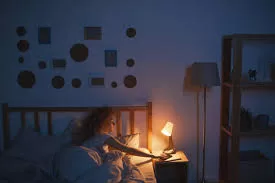In recent years, a growing body of research has highlighted the potential health risks associated with exposure to bright light at night, particularly its link to type 2 diabetes. A recent study from Flinders University has reinforced this connection, suggesting that reducing nighttime light exposure may be a simple and effective strategy for mitigating the risk of developing this chronic condition.
The study, published in The Lancet Regional Health – Europe, builds on earlier research which found a possible correlation between nighttime light exposure and increased diabetes risk. A November 2022 study revealed that outdoor artificial light at night could elevate the risk of diabetes, while a March 2023 study indicated that any light exposure during sleep might increase the likelihood of diabetes, obesity, and high blood pressure in older adults.
Researchers at Flinders University examined medical data from nearly 85,000 participants in the U.K. Biobank who were free of type 2 diabetes at the study’s onset. Each participant wore a light sensor on their wrist for a week to record their light exposure during both day and night. The findings showed that participants exposed to more light between 12:30 am and 6:00 am had a significantly higher risk of developing type 2 diabetes, independent of their daytime light exposure.
Andrew Phillips, PhD, associate professor in the College of Medicine and Public Health at Flinders University and senior author of the study, emphasized the importance of light as a modifiable environmental factor affecting health. “Circadian rhythms, which regulate all aspects of our physiology, including metabolism, are influenced by light. Disruption of these rhythms by nighttime light exposure can lead to metabolic dysfunction,” Phillips explained. “Our study highlights that decreasing light exposure at night could be a cost-effective way to improve health and potentially reduce the risk of type 2 diabetes.”
Jennifer Cheng, DO, section chief of Endocrinology at Hackensack Meridian Jersey Shore University Medical Center, remarked on the study’s implications for preventive care. “This study underscores the importance of good sleep hygiene in managing blood sugar levels. Simple measures like turning off electronics before bed can help mitigate diabetes risk,” Cheng noted.
David I. Geffen, OD, FAAO, director of optometric and refractive services at the Gordon Schanzlin New Vision Institute, emphasized the broader health benefits of reducing nighttime light exposure. “Our circadian rhythms can be disrupted by light, leading to a range of health issues including fatigue and digestive problems. Reducing nighttime light exposure not only helps with diabetes prevention but also supports overall well-being,” Geffen said.
While this study adds valuable insights into the relationship between nighttime light and diabetes risk, researchers acknowledge the need for further investigation to confirm these findings and understand the underlying mechanisms. As the evidence mounts, it appears that a simple adjustment—reducing exposure to bright light at night—could be a key step in lowering the risk of type 2 diabetes and improving health outcomes.












